Ingredients needed:
1 Egg
3 Egg Yolks
1 tsp Vanilla Extract
35g Unsalted Butter
60g Cake Flour
60g Fresh Whole Milk
For the meringue,
3 Egg Whites
85g Fine sugar
For whipping cream,
100g Whipping Cream
2 tsp Fine Sugar
28 x 28-cm flat square cake pan
Steps:
1. Preheat oven to 180°C
2. Line cake pan with parchment paper
3. Sift flour twice
4. Mix egg, egg yolks and vanilla extract and beat lightly
5. Place butter in a suacepan and heat gently until melted
6. Add sifted flour and cook through
7. Transfer butter-flour mixture into a bowl and add egg mixture a little at a time
8. Mix into a smooth batter using a spatula
9. Add milk and mix
10. Strain batter and set aside
11. In another bowl, whisk the egg whites till it is foamy
12. Add half the sugar and continue beating for a few mintues.
13. Add the remaining sugar and beat until stiff and shiny peak
14. Add one-third of the meringue into egg mixture and fold in lightly
15. Add the remaining meringue and continue folding
16. Pour in the batter into the cake pan and spread evenly with a spatula
17. Bake for 20 min
18. Allow it to cool before loosening the cake
19. Whip cream and castor sugar in a chilled mixing bowl until stiff peaks form
20. Turn the cooled souffle sponge onto a clean work surface
21. Peel off the parchment paper from the bottom of the sponge
22. Spread whipped cream in an even layer over the sponge and gently roll up sponge
23. Place in freezer to chill and set before serving
Some things to note

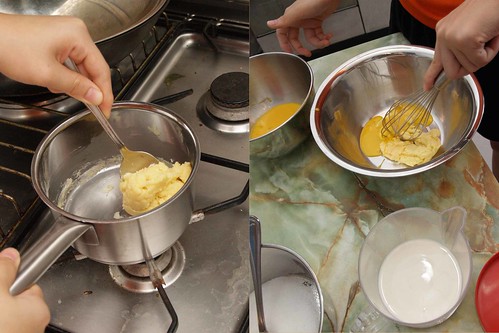
Note:
The gluten content of the flour makes the sponge hard. Cooking flour with butter weakens the gluten content in the flour, resulting in a light, bouncy and fluffy cake (Ishida K., 2009)


Note:
The meringue is essential for the souffle roll sponge to rise, so it must be stiff and stable (Ishida K., 2009)
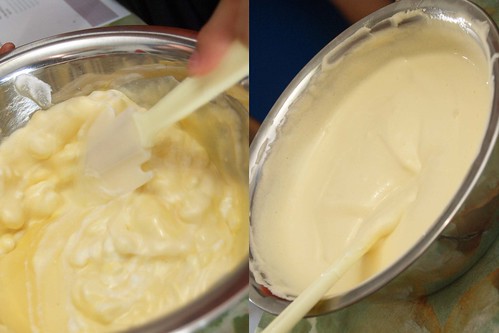
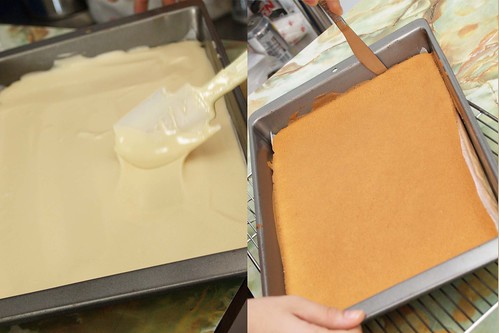
Possible Error:
Folding seems to be easy but for first timers or non-bakers like me, leaving the bottom bit at the bowl not mixed is quite common. To avoid, try to scrap the bowl to ensure every single bit is nicely incorporated, if not the sponge will have a starchy layer at the base.
The size of the baking pan does matter, if it is too small, the sponge will be too thick to roll. If it is too big, it will result in an easily overcooked sponge. Should the pan used differs from what are stated in recipes, oven temperature needs to adjust abit. If you are observant, the pan we used is not squarish but surface area is the same as a 28 x 28-cm pan.
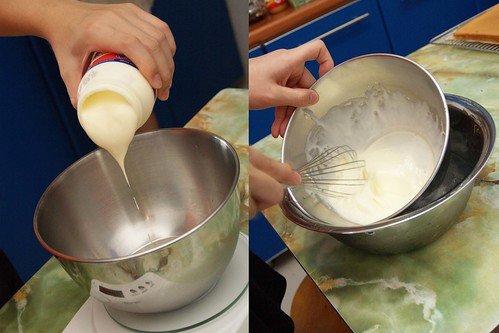

Note:
Apart from egg whites, cream is another petty ingredient and the bowl has to be extremely clean, no water, no oil or any possible contaminants.
Also, it is essential to whip cream over a bowl of ice water to keep it cold, otherwise the cream will become warm and curdle easily (Ishida K., 2009)
Use fresh (single) whipping cream and not the long-life variety of whipping cream. The whipping cream must also have at least 35% fat (Ishida K., 2009)

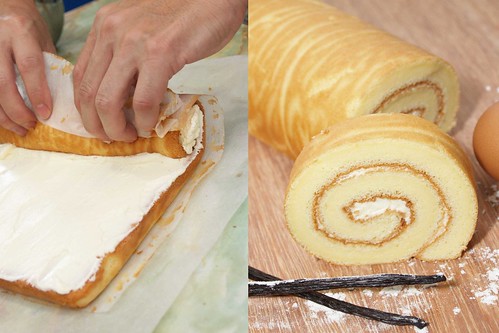
I always thought I can never bake and I don't seems to know what are my mistakes made after each attempt. It was only through patience of daddy and some of the training my sister has received in school that makes me realize what are some of the things to note when beating the meringue, the tricks to fold in the dry ingredients, etc.
And for those who are wondering why there is a recent surge in baking entries. Just bear with me for one more entry. Don't wish to elaborate much on what has happened over the span of 5 weeks but the good news is that I am ready to indulge and explore all the sweets I have been missing out. I just need some time to sort out the photos and write these entries, everything will be back on track.
Lastly, how do I find the taste of this souffle roll then? Indeed happy that this sponge can be rolled easily. Happy with the cream, light and refreshing but the sponge is too firm when compared to a regular swiss roll and to a certain extent tasted like a 鸡蛋糕. Now will some kind souls provide some tips to get a roll-able and soft sponge?

17 comments:
hi fen! nice to see u baking :) i tried this recipe before and i think its too eggy for me. in my opinion, i feel that if the cake is too soft or moist it wouldn't roll properly, hence i always prefer to use a biscuit sponge (where the whites & yolks are separated) instead of a genoise. the biscuit sponge is firmer hence easier to roll. then again it also depends on how u roll it. but i see your attempt is successful and yr roll is so pretty, so congrats :)
Hey Evan,
Thanks for dropping by. Was motivated by daddy's enthusiasm so end up baking a fair bit for the past few weeks.
Oh, saw your post on the green tea souffle roll, guess your orginal green tea roll recipe is better. That is quite soft, at least, not egg-y.
Alright, will take your advice to try Okashi's biscuit sponge.
Thank you for the compliment.
P.S. Saw your latest post on rose chiffon, that looks lovely and interesting. Now I am tempted to incoporate the rose extract in the chiffon mixture.
its nice to see yr bakes, really :) and all your baking utensils are so new and shiny! :D
yea the macha souffle roll from okashi treats is really disappointing. my original one is just a normal biscuit sponge and i just added macha powder inside :) like u, i'm still looking out for the perfect recipe, i STILL like breadtalk's best!
oh yes, u totally shd, the rose chiffon is nice! if u r willing to splurge, then get the nielsen massey's rose extract, its v nice!
how hv u been? i miss u.
Thank you for your compliment. All the baking utensils are bought by my dad and those are strictly used for baking.
Yea, breadtalk's matcha chiffon is indeed good. I do pick these up for a quick matcha fix.
Oh, thanks for the recommendation. Since I am in the experimenting phase, I am still on Redman products.
Trust things are fine with you. As for me, same old routine, nothing much has happened apart from me signing the papers to be legally bonded to Yuan.
The French souffle roll is a roulade or roll cake, it is not a swiss roll. Its sponge layer is supposed to be thinner and firmer than the thicker and softer swiss roll. It is therefore more elastic and easier to roll. It uses a different recipe from swiss rolls that use the soft sponge cake recipe.
Your roll layer is made too thick, the batter is also quite thick. A roll cake is supposed to have a thin cake layer containing much cream.
Roll cakes can be easier to roll when they are not cooled completely. If you wish to reduce the taste of eggs, you can try replacing some of the yolks with egg whites.
I tried a few soft sponge cake recipes before but the sponge ended up cracked or broken while rolling.
I recall you mentioning that Arinco King's roll cakes are french roulade cakes but this is far from Arinco King's heavenly sponge.
Hmm, thick batter... but the steps followed are exactly the same as stated in the recipe. Could I have overcooked the flour-butter mixture? Alternatively, I shall experiment with extra whites. Hopefully the souffle roll will be lighter.
P.S. As this cake is known as souffle roll, I can't help but to associate this cake to be as fluffy as a souffle. The egg-y texture caught me by surprise.
You should be able to prevent the sponge rolls from cracking while rolling, just increase the protein percentage in the recipe to make the sponge elastic. Sometimes the protein quality in eggs, milk(Meiji milk) and flour can affect the sponge's elasticity.
Arinco King's sponge is a roulade sponge because you can tell from its elastic texture that it only uses egg whites, so it is very different from other roll cakes.
Sometimes thick batter results from an inaccurate recipe, or more commonly due to the different types and qualities of flour used. Different brands and qualities of flours absorb liquids differently.
The 'souffle' in this souffle roll recipe is meant to refer to the savory type of souffle roll eaten with meat, not the dessert souffle.
http://www.dairygoodness.ca/recipes/asparagus-cheese-souffle-roll
Just to recap, a roulade(Arinco) cake only uses egg whites, so its cake layer can be thinner and elastic/firmer, it is less prone to cracks and can wrap around more cream. A swiss roll uses egg whites and yolks so its sponge is less elastic and brittle, it is more easier to crack so its cake layer has to be made thicker, and it can hold less cream/jam. Both types can be called 'roll cakes' since they both have the rolled shape. I think most people who are not familiar with baking have trouble distinguishing a roulade cake and swiss roll, but this is normal because both can look very similar. Also, some skilled bakers have the skill to make a swiss roll with a thin layer like a roulade's, which just adds to the confusion between the two types of roll cakes.
Take a look at this Japanese "Swiss style roll cake" recipe. Although it also uses egg yolks, the recipe allows the cake layer to be as thin as a roulade's.
Strawberry Roll Cake
http://www.cakepia.info/cooking/search/detail_e.html?LM_ID=685
Vanilla roll cake
http://www.cakepia.info/cooking/search/detail_e.html?LM_ID=924
Black tea roll
http://www.cakepia.info/recipe/23.html
Belgian Chocolate Roll Cake
http://www.cakepia.info/cooking/search/detail_e.html?LM_ID=849
chocolate rolls
http://www.cakepia.info/recipe/1049.html
http://www.cakepia.info/recipe/1126.html
Christmas roll(brittle texture)
http://www.cakepia.info/recipe/403.html
Christmas chocolate roll
http://www.cakepia.info/recipe/812.html
Recipe list in English:
http://www.cakepia.info/cooking/search/e_list.html
In Japanese:
Plain roll with milk
http://www.cakepia.info/recipe/1047.html
Plain rolls
http://www.cakepia.info/recipe/1125.html
http://www.cakepia.info/recipe/1019.html
http://www.cakepia.info/recipe/1020.html
On a side note, the traditional genoise type sponge used in small "petit fours" cakes:
http://www.cakepia.info/cooking/search/detail_e.html?LM_ID=927
French strawberry shortcake with soaked genoise sponge
http://www.cakepia.info/cooking/search/detail_e.html?LM_ID=837
Christmas shortcake
http://www.cakepia.info/recipe/563.html
Looks like a blackforest
http://www.cakepia.info/recipe/750.html
Uses a chiffon pan
http://www.cakepia.info/recipe/333.html
light cheese cake
http://www.cakepia.info/recipe/955.html
Here are some pictures of Japanese roll cakes.
http://store.shopping.yahoo.co.jp/shinkinedo/a5eda1bca52.html
I think when I previously mentioned roulade cakes(such has Arinco's), I wasn't specific enough. I actually meant to refer to them as 'meringue roulades'.
'Roulade' actually just means a French roll cake. But a 'meringue roulade' refers to a French roll cake made with egg whites. Arinco King cake rolls are French-influenced meringue roulades.
If people like me gets too used to knowing that the original French lemon roulade cakes only uses egg whites, they could mistakenly or gradually skip using the word 'meringue' when referring to meringue cakes, and just refer them as 'roulade cakes'.
French 'lemon roulade' recipes are not often known as 'lemon meringue roulades'. This is an example how the gradual change in food titles due to convenience can gradually lead to confusions in food types and lead to different styles and variations from the originals, for example the 'sponge cake', 'Blackforest cake', genoise sponge. Therefore studying food culture and history is also important to be aware of the true differences found in similar food types, or to maintain the original recipe.
Here are some meringue roulade recipes that uses only egg whites.
http://uktv.co.uk/food/recipe/aid/513012
http://www.yorkshirepost.co.uk/custompages/CustomPage.aspx?pageID=68105
http://www.waitrose.com/recipe/Raspberry_Meringue_Roulade.aspx
Here is a site that clearly list the difference between a swiss roll and a normal roulade
http://www.asianonlinerecipes.com/rss/item/1741
"Swiss rolls are made from a light sponge mixture that contains flour. Roulades are based on a whisked egg mixture and contain very little or no flour, and are moister and softer than Swiss rolls. To prevent a Swiss roll cracking when rolled, trim off its crusty edges then, while it is still warm, put it on greaseproof paper dusted with caster sugar. Roll it up loosely, rolling the paper with it, and leave it to cool in its wrapping. Then gently open up the roll slightly, remove the paper and spread the interior with jam, lemon or lime curd or cream.
Roulades are easier to roll, so can be filled before rolling up. They do usually crack when being rolled, but look attractive when dredged with icing sugar and decorated."
If you want to prevent the roll from cracking you can also try rolling the sponge layer into a loose spiral rather than a compact spiral. Or you can just roll it into a tube and fill it with lots of cream like the arctic roll and some Japanese roll cakes.
From my understanding from Oksahi, I thought cooking the butter-flour mixture will reduce the gluten content. If increasing the gluten content helps, the cooking step may not be necessary after all. No?
Seems like I should change the flour unless I am daring enough to reduce the amount of flour required.
Oh, didn't know souffle has meaning in the savoury context.
I always mixed up roulade and swiss roll. Sometimes, the taste between the two seems to be similar due to the mislabelling of cakes when purchased outside.
Wah, that is alot of recipes and information. Will need some time to digest. Thanks.
I have absolutely no idea if cooking the butter-flour mixture will reduce the gluten content. I am totally unfamiliar with the souffle roll recipe, which is a very rare and strange recipe to me. If I were you, I would not use the recipe anymore due to the strong egg taste.
I think the main differences between roulade and swiss roll is this:
Roulade: Is a small roll with thin and delicate sponge layer. Sponge layer is more elastic due to higher egg to flour ratio. Made with more eggs and fat with less flour therefore is moist and fresh so it has to be carefully preserved in clingwrap and stored in the fridge at all times. Since it is refrigerated, it is usually filled or coated with fresh cream.
Swiss roll: Uses the traditional soft sponge cake recipe therefore has a thick layer and thick roll The sponge is dry, brittle and spongy. It is dry so it does not have to be kept in the fridge therefore is filled with non-fresh cream. Commonly seen in neighbourhood bakeries.
I can see many fusions of the swiss roll with roulades nowadays.
Arinco King's rolls has the elasticity and delicate texture of roulade but its sponge layer is made thick to resemble a swiss roll. The sponge looks fresh and moist not dry, elastic and firm not brittle. Its high egg to flour content means it has to be preserved in the fridge.
You can see at Polar Puffs, their small rollcakes are actually swiss rolls but are made small to look like slim roulades. However, they are made with a dry sponge.
Sometimes there is the merging of the swiss roll and roulade. The sponge can taste in between.
The rolls at Rich and Good cake shop is also a cross-between the roulade and swiss roll. Firstly, it looks as slim as a roulade. Its sponge looks moist but also dry, looks eggy/elastic but also looks soft, dry and brittle. The fusion of roulade and swiss roll found there is the reason why their rolls are perceived to be unique and got to become more popular than the usual dry and brittle big swiss rolls sold elsewhere. They are nicer to the bite and their fusion recipe allows the rolls to be less expensive than the fridge-kept roulade.
Hmm... ok... Anyway, talking about eggs, I saw the Hokkiado air-flown white eggs from Isetan but they are way too expensive, considering they are in Singapore for close to a week, they are priced at $8.60 for 6. For that price and that my recipe is not optimised, it is quite expensive and buying a slice of good cake might be better bet...
Didn't manage to find the Japanese flour at Isetan, guess I will have to try my luck at Meidi-ya.
Surprisingly to hear that polar roll cakes are made from dry sponge since they are moist in my opinion.
Didn't know that some of the rolls I have tried are examples of hybrids, will play around with other recipes to see what are the impact of various ingredients.
You don't necessarily have to buy white eggs from Japan, you can try some from elsewhere. Meidi-ya has every Japanese ingredient you need. You can try the bigger Daiso stores too.
Cakes have different levels of dryness and absorb mouth fluids differently. Polar roll cakes are moist but are dry compared to other cake sponges. They can even withstand icing.
Looks like Meidi-ya is a better bet. O.o, if Daiso is to carry it, then it will be alot cheaper and affordable.
Thanks for the clarification...
Oh, I did try to bake a pandan chiffon cake but it turned out too sour. Might be due to the coconut milk, baking powder and cream of tartar. Thinking of trying it again with a different brand of coconut milk, minus the baking powder and cream of tartar, hopefully it will help.
You can't find white eggs at Daiso, just the little little things you could use in baking like some types of flours and green tea.
The pandan chiffon cake recipe at Prima's site uses 1/4 tsp cream of tartar, maybe you added too much?
Lol... I was refering to Japanese flour when speaking about Daiso.
I am currently using the bakeable green tea powder bought from Phoon Huat, not sure will the taste of the prenium ones from Taka change after heating.
I didn't add alot of cream of tartar but dad tasted the meringue and it was sour. Will let you know the effect of the chiffon after changing the brand of coconut milk and eliminating the use of baking powder and cream of tartar.
P.S. I had some pandan chiffon back to back from Bengawan Solo and a neighbourhood bakery and apparently I prefer the latter since it is softer with a weaker tangy after-taste. But careful observation seems to indicate that Bengawan Solo has a higher content of pandan extract due to the strong colour; also richer in taste (possibility) due to more coconut milk.
If that is the case, the use of the wrong brand and quantity of coconut milk might have lead to such outcome. Will have to experiment it again when I have the time...
Thank god for your step-by-step pictures. I tried making the matcha souffle roll last week but it was unsuccessful. Same for my chiffon cake (from okashi too) and really disappointed :(
My butter mix didn't look as much as yours. And it's so hard to gauge the texture of the meringue!
Post a Comment